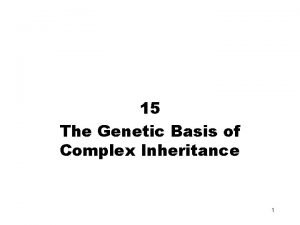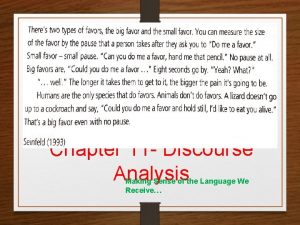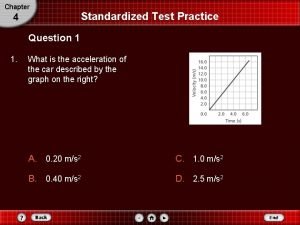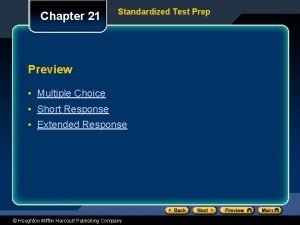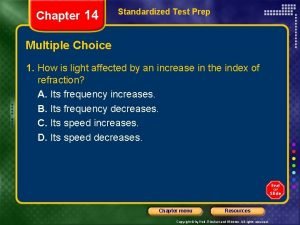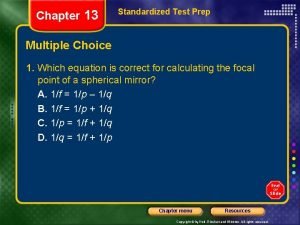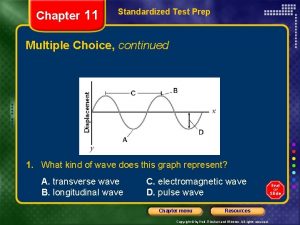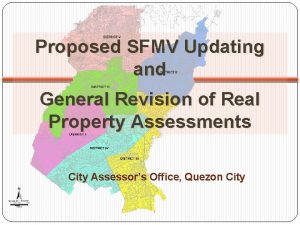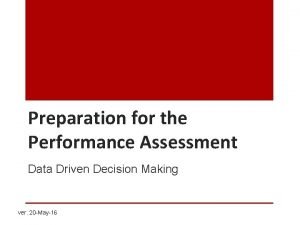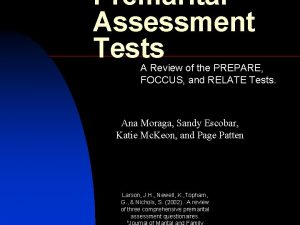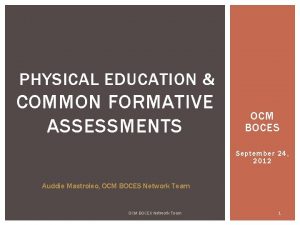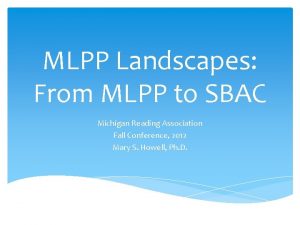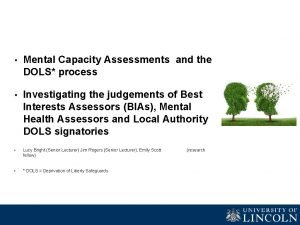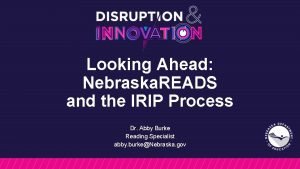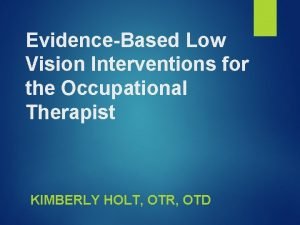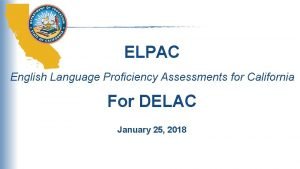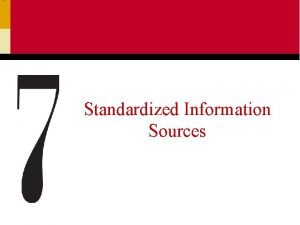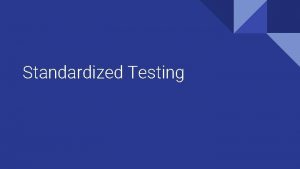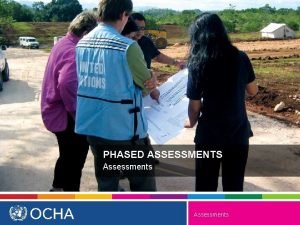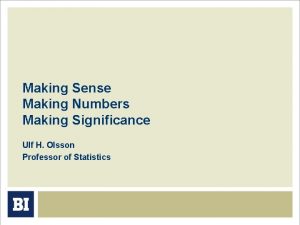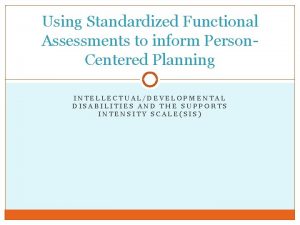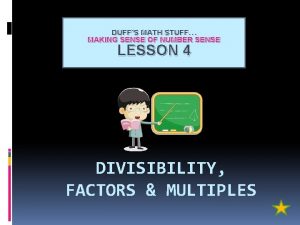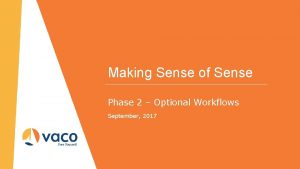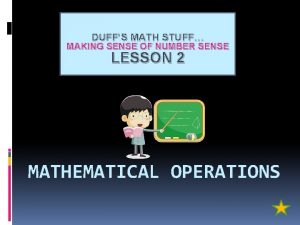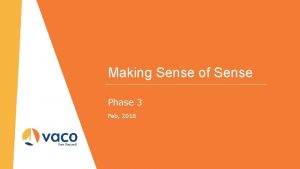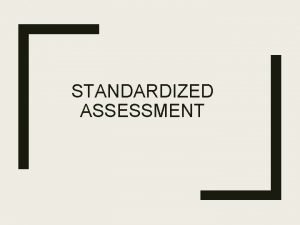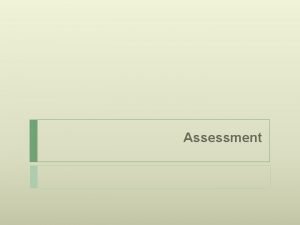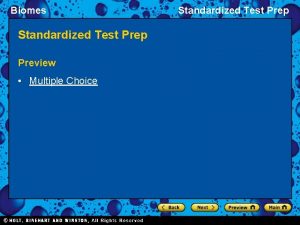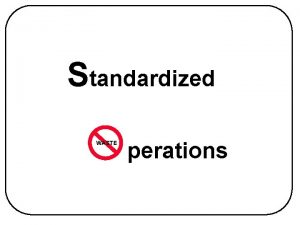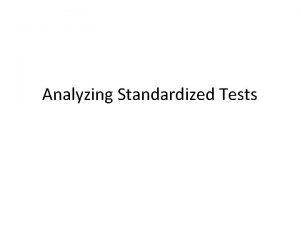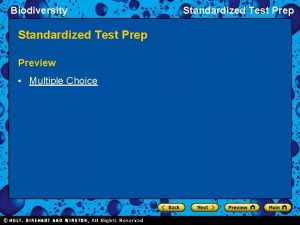USING STANDARDIZED ASSESSMENTS Chapter 10 Making Sense Out





























- Slides: 29

USING STANDARDIZED ASSESSMENTS Chapter 10: Making Sense Out of Standardized Test Scores

The SAT and the ACT: College Entrance Exams Scholastic Aptitude Test: First administered in 1926, designed assist admissions officials in determing which applicants should be admitted to a group of elite universities. Originally a group-administrated intelligence test designed to compare test-takers on verbal, quantitative, and spatial aptitudes. Early emphasis on ‘inherited intelligence.

The SAT and the ACT: College Entrance Exams Less emphasis on this now, because of better understanding of the nature of human intelligence. Less ‘inherent’ and more ‘environmental’. SAT: Three sections: Critical Reading, Writing, and Mathematics. SAT: Majority of items are multiple-choice, except for a few math items and a 25 minute essay in writing section.

The SAT and the ACT: College Entrance Exams SAT: Takes about three hours to administer. Each section uses a scale-score range from 200 – 800. The highest score a student can earn on the SAT is 2400 (total points possible on the exam). Both the SAT and the ACT are considered ‘aptitude’ tests.

The SAT and the ACT: College Entrance Exams Sections are not weighted equally. Writing section was added in 2005. Writing section is worth about 20% of student’s scores. The test is still owned by the College Board, but since 1947 the SAT has been developed and administered by the Educational Testing Service. Both entities are not-for-profit.

The SAT and the ACT: College Entrance Exams PSAT: A less demanding version of the SAT is administered once in year in October – typically to high school students in sophomore of junior years. SAT: Administered through the nation on specific occasions during the year.

The SAT and the ACT: College Entrance Exams American College Test: Following WWII and GI Bill of Rights (federally funded college tuition to ex-military personnel), substantially increased need for college entrance exams. University of Iowa: E. F. Lindquist: SAT designed for ‘elite’ colleges, wasn’t a suitable exam. ACT was designed to be an achievement test. Predictive of a high school student’s academic success in college, and a measure of a student’s ‘educational development’.

Exams. The SAT and the ACT: College Entrance ACT: English, Mathemataics, Reading, and Science. 30 minute essay writing – optional. Takes about three hours to complete. ACT routinely solicits content suggestions from large samples of secondary teachers, curriculum coordinators and college professors in the four core subject areas.

The SAT and the ACT: College Entrance Exams Secondary educators identify skills and content the students learn by end of junior year. Professors are asked for input on esssential secondary level skills. Every ACT item is multiple-choice. Student gets one point for every correct answer. No points subtracted for wrong answers (as in SAT).

The SAT and the ACT College Entrance Exams: ACT: Numbers correct on each section of the exam are converted to a ‘scaled’ score of 1 – 36. These numbers are converted to an overall average. Optional writing test: 2 – 12 points scale. Early ACT: for younger students. EXPLORE for 8 th and 9 th grade students. PLAN for 10 th graders.

SAT and ACT: Test preparation materials available commercially. Prep courses, etc. Children from more affluent families have greater access to the most costly test preparations. 25% of academic success in college is associated with a high school student’s performance on SAT or ACT.

Standardized Assessment: Means that all students answer the same items, take the test under the same conditions and are scored the same way. Extensive pretesting and pre-selection of test items prior to publication of standardized assessments. This is what distinguishes ‘standardized testing’ from other formal assessments. Can be ‘criterion’ referenced or ‘norm’ referenced, but the majority are ‘norm’ referenced.

Categories of Standardized Testing: Achievement Tests: Measure the present knowledge base of students in specific academic areas. Dominant form of Standardized Testing. Ex: Stanford Achievement Test (SAT) 9 th ed. , Iowa Test of Basic Skills (ITBS), Terra Nova/Comprehensive Tests of Basic Skills. Aptitude Tests: Measure the potential for learning in a given educational setting. Ex: American College Test (ACT), Scholastic Assessment Test (SAT).

Categories of Standardized Testing: Intelligence Tests: attempt to measure general mental ability. Usually administered as part of the psychoeducational battery required by federal law for special education referral. Stanford Binet Intelligence Scale (4 th Edition) (significant upgrades since original version developed by Terman (1916). IQ has been replaced with the Standard Age Score (SAS). Wechsler Test Battery: Uses IQ score, three versions: WPPSI-R: Ages 3 – 7, WISC-III: Ages 6 – 16, WAIS III: Ages 16+

Historic Views of Intelligence Testing: 1900 s – 1960 s American Hereditarians: Intelligence as an inherited trait: Early IQ test users believed intelligence was an ‘inherited’ trait. Measurement of innate traits. Believed the test measured a physical property of a person’s brain. Also claimed IQ differences were inherent in different ethnic groups. Frightening misuse of testing: led to racist policies in the US, immigration quotas, involuntary sterilization for ‘low IQ’ 1920 s – 1960 s.

Transition to Achievement Tests: 1950 - 60 s 1950 s – 60: Group Intelligence Tests: IQ was dominant form of group testing in the public schools. 1970 s: Transition to Achievement Tests. Historical use of testing as ‘discriminatory’ practice came under fire. 1980 s – 1990 s: High Stakes Testing. Byproduct of national political agendas: A Nation at Risk (1983) – Ronald Regan’s Administration.

High Stakes Testing: No Child Left Behind: (2000) – George Bush’s Administration. State developed assessments as part of this emphasis have been discussed but not yet implemented. States required to publish pass/fail scores following federally regulated guidelines. To be Continued. . .

Categories of Standardized Achievement Tests: Group Achievement Tests: assess general and basic skills of large groups of students across different states. They are based on national norms and developed by national testing companies. (SAT, ITBS, etc. ) Statewide Assessment Tests: assess a variety of skills of students within one state and are aligned with state standards and instructional objectives. Tests developed at state level. (State Core Testing)

Categories of Standardized Achievement Tests: (cont. ) Diagnostic Achievement Tests: Assess specific skills of students in areas such as reading or mathematics. Developed by major test publishing companies, these tests are often used to diagnose specific learning problems or learning disabilities. Ex: Woodcook-Johnson Psycho-Educational Battery – Revised, Key Math – Revised Inventory, etc.

Issues: Group Achievement Tests Stanford Achievement Test (9 th ed. ) Iowa Tests of Basic Skills Terra Nova/Comprehensive Tests of Basic Skills. Group Achievement Test Content: geared toward specific knowledge levels believed appropriate for certain age or grade. Cover a broad range of academic knowledge including: reading comprehension, vocabulary, spelling, science, social science, listening skills, math computation and concepts, study skills, advanced math.

Issues: Group Achievement Tests Norm Referenced Scoring: All students who test are compared against the ‘norm’ -- students are compared a spot on the continuum of the ‘curve’. Ex: 80% score means that students performed at a level equal to or better than 80 out of 100 students tested. Multiple choice questions. Widely used. Widely criticized. Inadequate measure of skill application. Example Test Questions: A blacksmith is someone who: a. makes horseshoes b. fixes pipes c. builds houses d. chops wood

Issues: Statewide Assessments Statewide Assessment: Developed at state level. Usually a closer ‘fit’ with curriculum taught. Valid within the state for which it was designed. Criterion Referenced (a certain ‘criterion’ or ‘benchmark’ is set for mastery): Evaluates students on the basis of a specific performance standard. Number of students ‘passing’ measured by those that meet the criteria (70% passing, etc. ) regardless of how many meet or surpass the performance standard.

Issues: Diagnostic Achievement Tests Used to: (1) Pinpoint specific academic problems. (2) Determine special education placements. 1. Wood-cock Johnson Psycho-Educational Battery 2. Key Math-Revised Inventory 3. Peabody Individual Achievement Test 4. Stanford Diagnostic Reading and Mathematics 5. Wide Range Achievement Test 6. Metropolitan Diagnostic (reading, math, language) 7. May include IQ: WIPPSI, WISK, WAIS

Statistical Measures in Testing: Measures of Central Tendency: mean, median, mode (see p. 229) Measure of Validity: standard deviation.

Statistical Measures in Testing: Scaled Scores: raw scores transformed to a common scale which can be statistically used to compare. Example: SAT: 800 Stanines: Score of 1 – 9: (rough measure). Scaled to ‘normal curve’. 1= low, first 4%, 9 = high, top 4%.

Statistical Measures in Testing Age-equivalent scores, Grade-equivalent scores. Basals: Base line or initial testing point for student. Where information is easy enough for student. Ceilings: Upper limit of test administration. Where information becomes too difficult for students.

Parent Conferences and Test Scores: Maintain student privacy and confidentiality of records. Focus on information as a place to begin making improvements, not ‘set in stone’.

Parent Conferences and Test Scores Examine discrepancies between various subtests and what is actually taught in the classroom. Understand how test is scored. Be able to explain to parents. Tests can sometimes put our kids in ‘boxes’.

References: Banks, S. R. , (2009). Classroom assessment: Issues and practices. Longrove IL: Waveland Publishers, pp. 215 – 236. Popham, W. J. , (2011). Classroom assessment: What teachers need to know, 6 th ed. Boston/NY: Pearson Publishers, pp. 307 – 333.
 You're my kryptonite one direction
You're my kryptonite one direction Dominant genetic variance
Dominant genetic variance Narrow sense heritability vs broad sense heritability
Narrow sense heritability vs broad sense heritability Standardized menu
Standardized menu Making sense of discourse analysis
Making sense of discourse analysis Chapter 4 standardized test practice answers
Chapter 4 standardized test practice answers A rock climber's shoe loosens a rock and her climbing buddy
A rock climber's shoe loosens a rock and her climbing buddy Test prep preview
Test prep preview Chapter 14 standardized test practice answers
Chapter 14 standardized test practice answers Chapter 13 standardized test prep answers
Chapter 13 standardized test prep answers 10-6 standardized test prep answers
10-6 standardized test prep answers Chapter 2 chapter assessment
Chapter 2 chapter assessment Chapter 19 standardized test practice answers
Chapter 19 standardized test practice answers Chapter 3 standardized test practice answers
Chapter 3 standardized test practice answers What is inference
What is inference War making and state making as organized crime summary
War making and state making as organized crime summary List out the steps involved in making of pochampalli saree
List out the steps involved in making of pochampalli saree Making strategy: mapping out strategic success
Making strategy: mapping out strategic success General revision of assessments and property classification
General revision of assessments and property classification Performance assessment examples
Performance assessment examples Premarital tests or assessments
Premarital tests or assessments Formative assessments in physical education
Formative assessments in physical education Strength and weaknesses of product-oriented assessment
Strength and weaknesses of product-oriented assessment Mlpp assessments
Mlpp assessments Six dols assessments
Six dols assessments Irip
Irip Strengths and weaknesses assessment
Strengths and weaknesses assessment Eccentric viewing techniques occupational therapy
Eccentric viewing techniques occupational therapy Elpac proficiency levels
Elpac proficiency levels Cte technical skills assessments.azed.gov/student
Cte technical skills assessments.azed.gov/student


